Electric heating elements, types of heating elements depending on their purpose
TEN is called a tubular electric heating device, made in the form of a metal, glass or ceramic tube, in the center of which a heater is located, as a rule, it is a thread or a spiral made of nichrome.
The space between the heater and the pipe is filled with an electrical insulator with sufficient thermal conductivity and high dielectric properties, while being resistant even to very high temperatures.
The nichrome heater, in turn, has such a resistance to provide the necessary heat output and the appropriate temperature on the surface of the heating element.
The first patent (US Patent #25532) for the heating element was issued to George Simpson on September 20, 1859.
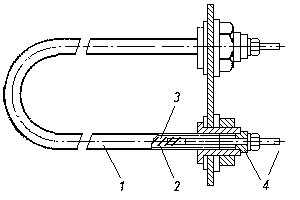
The main parts of the heating element:
-
1 — Pipe;
-
2 — Heating element;
-
3 — Insulation layer;
-
4 — Contact group.
Pipes from poorly exposed corrosion of metals it is usually used for the production of heating elements intended for heating non-aggressive media. Most often, metal pipes of heating elements can be found in domestic heating appliances and in some industrial installations.
Glass is chemically almost inert, which is why glass tubes are used in heating elements of industrial installations designed to heat chemically aggressive environments. Glass tubes can also be found in household heaters and infrared saunas. Ceramic pipes or precious metal pipes are extremely rare and are considered more of an exception for special occasions.
Depending on the purpose of the heating element, the diameter of the pipe can be from 6 to 24 mm.
Metal alloys with high electrical resistance, such as constantan and nichrome, are often used as the material for the heating element of the heating element. In special cases, special ceramics or other special materials are used.
The function of the insulating layer is to prevent contact of the helix (or thread) with the pipe, while transferring the thermal energy to the surface of the pipe as efficiently as possible.
To connect the heating element to the electrical circuit, a contact group is used, usually these are conductive terminals located on insulating inserts. In this case, the configuration of the terminals can be one-sided or two-sided. In the first case, the contact wires are located on one side of the heating element, in the second, the wires are on both sides.
Individual groups of heating elements are equipped with additional elements, for example, from 2000.the heating elements of dishwashers and washing machines necessarily have a thermal protector, and the heating elements of boiler water heaters are supplemented with a magnesium anode rod to extend the resource of heating elements.
What are the heating elements depending on their purpose?
Air heating elements
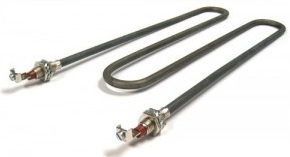
Such heating elements are the basis of industrial and domestic air heaters, air curtains, convectors, drying chambers. They are smooth tubular or ribbed and curved. Their temperature can reach 450 °C.
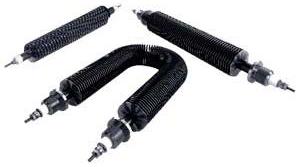
Fin heating elements are mainly intended for heating air, moving or still, but in rare cases can be used to heat liquids. Structurally, the finned heating element has a double-ended tube with a circular cross-section, to the active surface of which the fins adhere tightly.
The fins are made of a corrugated steel strip that is spirally wound around the tube. The strip is approximately 0.3 mm thick and 10 mm wide. To make the coefficient of thermal expansion the same everywhere, use a strip of carbon steel or stainless steel.
The fins create a large area, as a result of which the load on the heating element is reduced up to 2.5 times compared to the version of the heating element without fins. The length of such a heating element is from 32 cm to 1 meter, and the shape can be straight or U-shaped.
Heating elements for water
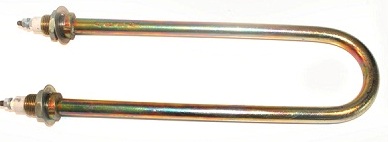
These heating elements are used in boilers, autoclaves, washing machines and dishwashers, etc., where they heat water (liquid medium) up to 100 ° C.If it is necessary to solve more serious problems, then blocks of heating elements are used to obtain a higher heat output.
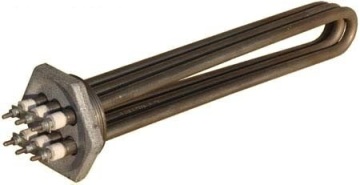
For domestic purposes (for example, with boilers), the heating element must be equipped with a thermostat so that the water temperature does not exceed 80 ° C, this is necessary, among other things, to save electricity. To protect against moisture penetration, the ends of the water heating elements are reliably sealed, and the contact bars are surrounded by a dense insulating dielectric shell.
The heating elements are flexible
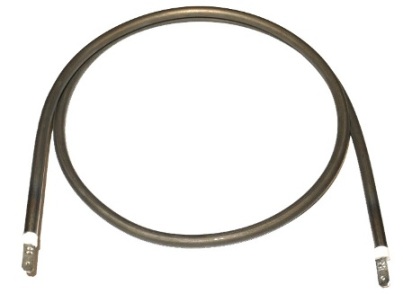
In hot systems and molds, flexible heating elements are useful and simply not replaced. They are convenient in that they can be bent into any shape, and the heating of the surface will be uniform. Loop heating or heating of hot runner systems is impossible without the formed heaters. The flexible heating elements are available in various sizes and fit comfortably in ducts.
Flexible heating elements for underfloor heating - heating cables - are especially noteworthy. A separate class of flexible heating elements is a self-regulating cable.
Cartridge heating elements
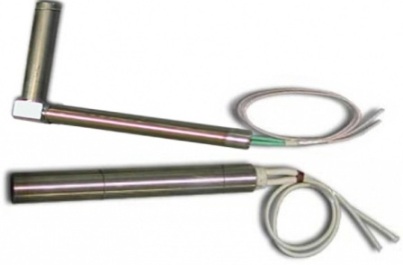
They are used in industrial units. Compact cartridge heating elements are used in the processing of polymer materials, injection press nozzles are equipped with cartridge heating elements, packaging machines are glued thanks to cartridge heating elements.
The range of application of cartridge heating elements is very wide: foundry, shoe industry, production of laboratory and medical equipment, automotive and woodworking industry, etc. The heating elements are attached using strips and fittings.
